Richard Sharpe Shaver
| Richard Sharpe Shaver | |
|---|---|
| Born |
October 8, 1907 Berwick, Pennsylvania, USA |
| Died |
November 5, 1975 Summit, Arkansas, USA |
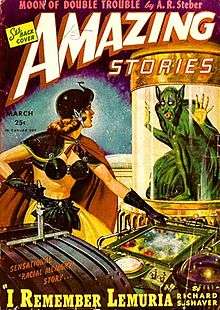
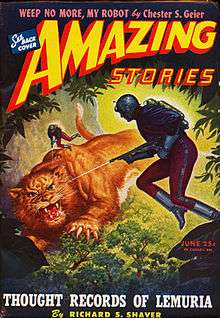
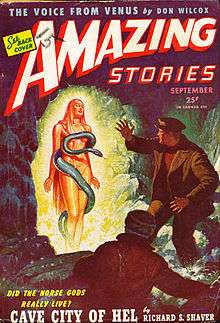
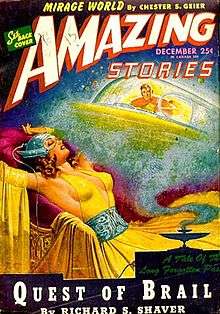

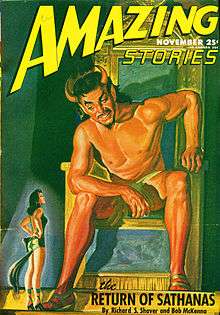

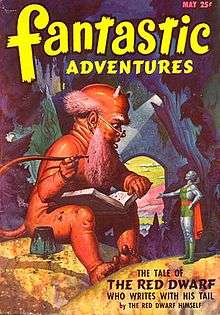
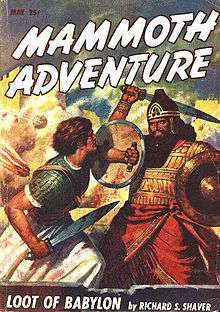
Richard Sharpe Shaver (October 8, 1907 Berwick, Pennsylvania – November 5, 1975 Summit, Arkansas) was an American writer and artist.

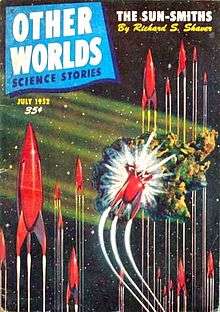
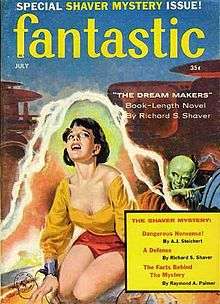
He achieved notoriety in the years following World War II as the author of controversial stories which were printed in science fiction magazines (primarily Amazing Stories), in which he claimed that he had had personal experience of a sinister, ancient civilization that harbored fantastic technology in caverns under the earth. The controversy stemmed from the claim by Shaver, and his editor and publisher Ray Palmer, that Shaver's writings, while presented in the guise of fiction, were fundamentally true. Shaver's stories were promoted by Ray Palmer as "The Shaver Mystery".
During the last decades of his life, Shaver devoted himself to "rock books" — stones that he believed had been created by the advanced ancient races and embedded with legible pictures and texts. He produced paintings based on the rock images and photographed the rock books extensively, as well as writing about them. Posthumously, Shaver has gained a reputation as an artist and his paintings and photos have been exhibited in Los Angeles, New York and elsewhere.
Biography
Shaver claimed to have worked in a factory where, in 1932, odd things began to occur. As Bruce Lanier Wright notes, Shaver "began to notice that one of the welding guns on his job site, 'by some freak of its coil's field atunements', was allowing him to hear the thoughts of the men working around him. More frighteningly, he then received the telepathic record of a torture session conducted by malign entities in caverns deep within the earth". According to Barkun, Shaver offered inconsistent accounts of how he first learned of the hidden cavern world, but that the assembly line story was the "most common version".[1] Shaver said he then quit his job, and became a hobo for a while.
Barkun writes that "Shaver was hospitalized briefly for psychiatric problems in 1934, but there does not appear to have been a clear diagnosis".[2] Barkun notes that afterwards, Shaver's whereabouts and actions cannot be reliably traced until the early 1940s. In 1971, Ray Palmer reported that "Shaver had spent eight years not in the Cavern World, but in a mental institution".[3][4]
The Shaver Mystery
During 1943, Shaver wrote a letter to Amazing Stories magazine. He claimed to have discovered an ancient language he called "Mantong", a sort of Proto-Human language which was the source of all Earthly languages. In Mantong, each sound had a hidden meaning, and by applying this formula to any word in any language, one could decode a secret meaning to any word, name or phrase. Editor Ray Palmer applied the Mantong formula to several words, and said he realized Shaver was onto something.
According to Palmer (in his autobiography The Secret World), Palmer wrote back to Shaver, asking how he had learned of Mantong. Shaver responded with an approximately 10,000 word document entitled "A Warning to Future Man". Shaver wrote of extremely advanced prehistoric races who had built cavern cities inside the Earth before abandoning Earth for another planet due to damaging radiation from the Sun. Those ancients also abandoned some of their own offspring here, a minority of whom remained noble and human "Teros", while most degenerated over time into a population of mentally impaired sadists known as "Deros" — short for "detrimental robots". Shaver's "robots" were not mechanical constructs, but were robot-like due to their savage behavior.
These Deros still lived in the cave cities, according to Shaver, kidnapping surface-dwelling people by the thousands for meat or torture. With the sophisticated "ray" machinery that the great ancient races had left behind, they spied on people and projected tormenting thoughts and voices into our minds (reminiscent of schizophrenia's "influencing machines" such as the Air loom). Deros could be blamed for nearly all misfortunes, from minor "accidental" injuries or illnesses to airplane crashes and catastrophic natural disasters. Women especially were singled out for brutal treatment, including rape, and Mike Dash notes that "[s]ado-masochism was one of the prominent themes of Shaver's writings".[5] Though generally confined to their caves, Shaver claimed that the Deros sometimes traveled with spaceships or rockets, and had dealings with equally evil extraterrestrial beings. Shaver claimed to possess first-hand knowledge of the Deros and their caves, insisting he had been their prisoner for several years.
Palmer edited and rewrote the manuscript, increasing the total word count to a novella length of 31,000. Palmer insisted that he did not alter the main elements of Shaver's story, but that he only added an exciting plot so the story would not read "like a dull recitation".[1] Retitled "I Remember Lemuria!"; it was published in the March 1945 issue of Amazing.[6] The issue sold out, and generated quite a response: between 1945 and 1949, many letters arrived attesting to the truth of Shaver's claims (tens of thousands of letters, according to Palmer). The correspondents claimed that they, too, had heard strange voices or encountered denizens of the Hollow Earth. One of the letters to Amazing Stories was from a woman who claimed to have gone into a deep subbasement of a Paris, France building via a secret elevator. After months of rape and other torture, the woman was freed by a benevolent Tero.[7] Another letter claiming involvement with Deros came from Fred Crisman, later to gain notoriety for his role in the Maury Island Incident and the John F. Kennedy Assassination. "Shaver Mystery Club" societies were created in several cities. The controversy gained some notice in the mainstream press at the time, including a mention in a 1951 issue of Life magazine.
Palmer claimed that Amazing Stories magazine had a great increase of circulation because of the Shaver Mystery, and the magazine emphasized the Shaver Mystery for several years. Barkun notes that, by any measure, the Shaver Mystery was successful in increasing sales of Amazing Stories. There was disagreement as to the precise increase in circulation, but Barkun notes that reliable sources reflect an increase in monthly circulation from about 135,000 to 185,000.[1]
From 1945 to 1948, Barkun notes that about 75% of the issues of Amazing Stories featured Shaver Mystery content: sometimes to the near-exclusion of any other topic. Historian Mike Dash declares that "Shaver's tales were amongst the wildest ever spun, even in the pages of the pulp science fiction magazines of the period".[5] He also published in Other Worlds magazine; the first issue featured his story "The Fall of Lemuria".
Many science fiction fans felt compelled to condemn the Shaver Mystery as "the Shaver Hoax". These fans, already distressed by Palmer's shift away from the literary or hard science fiction of earlier years to often slapdash space opera, organized letter-writing campaigns to try to persuade the publishers of Amazing Stories to cease all Shaver Mystery articles. In fact, Palmer printed a number of critical or skeptical letters sent to Amazing Stories, and he and other contributors occasionally rebutted or replied to such letters in print. As Bruce Lanier Wright notes, "[t]he young Harlan Ellison, later a famously abrasive writer, allegedly badgered [Palmer] into admitting that the Shaver Mystery was a 'publicity grabber'; when the story came out, Palmer angrily responded that this was hardly the same thing as calling it a hoax".[3] Dash writes that the "critics of the 'Shaver Mystery' were quick to point out that its author was suffering from several of the classic symptoms of paranoid schizophrenia, and that many of the letters pouring into Amazing recounting personal experiences that backed up the author's stories patently came from the sorts of people who would otherwise spend their time claiming that they were being persecuted by invisible voices or their neighbor's dog".[5]
During 1948, Amazing Stories ceased all publication of Shaver's stories. Palmer would later claim the magazine was pressured by sinister outside forces to make the change: science fiction fans would credit their boycott and letter-writing campaigns for the change. The magazine's owners said later that the Shaver Mystery had simply run its course and sales were decreasing.
The Shaver Mystery Clubs had surprising longevity: representatives of a club discussed the Shaver Mystery on John Nebel's popular radio show several times through the late 1950s. Nebel said he thought the discussion was entertaining, but in extant recordings he was also skeptical about the entire subject.
Even after the pulp magazines lost popularity, Palmer continued promoting the Shaver Mystery to a diminishing audience via the periodical The Hidden World. Lanier describes the magazine as "Shaver in the raw" with little of Palmer's editing. Shaver and his wife produced the Shaver Mystery Magazine irregularly for some years.
Rock Books
During the 1960s and 1970s, now living in obscurity, Shaver searched for physical evidence of the bygone prehistoric races. He claimed to find it in certain rocks, which he believed were "rock books" that had been created by the great ancients and embedded with legible pictures and texts. For years he wrote about the rock books, photographed them, and made paintings of the images he found in them to demonstrate their historic importance. He even ran a "rock book" lending library through the mail, sending a slice of polished agate with a detailed description of what writings, drawings, and photographs he claimed were archived by Atlanteans inside the stone using special laser-like devices.
Shaver never succeeded in generating much attention for his later findings during his lifetime, but there have been exhibits of Shaver's art and photographs in the years since his death. Artist Brian Tucker created an exhibition about Shaver's life and work in 1989 at California Institute of the Arts, and presented Shaver's work again in later years at the Santa Monica Museum of Art and the Guggenheim Gallery of Chapman University in Orange County, California. In 2009, Tucker curated "Mantong and Protong", an exhibition at Pasadena City College which pairs Shaver's work with that of Stanislav Szukalski. Shaver's art has also been exhibited in galleries in New York City, and in a traveling exhibition of "outsider photography" called "Create and Be Recognized" that originated at the Yerba Buena Center for the Arts in San Francisco in 2004. In that exhibition, which toured the USA, Shaver's "rock book" photography was grouped with works by famous "outsider artists", including Henry Darger and Adolf Wolfli.
Influence and references to the Shaver Mystery
After its initial effect on the Amazing Stories readership, the Shaver Mystery continued to influence science fiction and other general literature. Many modern books, movies, and games make references to Deros and other aspects of Shaver's story. The Shaver Mystery has also influenced believers of paranormal phenomena. This has taken various forms, from suspected connections between the Deros and UFOs to appearances of the Deros in the mythology of the Church of the Subgenius.
Shaver in Science Fiction, Fantasy and Horror
As noted above, writer Harlan Ellison reportedly thought the Shaver Mystery was nonsense. However, he did use elements of the Shaver Mystery in one of his own science fiction short stories. "From A to Z, in the Chocolate Alphabet" featured 26 brief stories, some a few pages long, others comprising only a few sentences. One story, "The Elevator People" reports that "[t]here are five hundred buildings in the United States whose elevators go deeper than the basement". Those unfortunates who descend to the caverns emerge nearly catatonic after being "treated" by the evil cavern inhabitants.[8]
The 2004 Japanese horror movie Marebito, directed by Takashi Shimizu, also references Shaver's work and the Deros. The movie references Shaver's books directly, as well as showing Deros at several times during the film.
Richard Shaver and the Deros are mentioned on a plaque in Shivers, next to a sculpture of a Dero in the "Subterranean World" room.
Both Shaver and his work, as well as Amazing Stories, are amongst the esoteric and unusual ideas referred to in the Philip K. Dick novel Confessions of a Crap Artist.
In the role-playing game Dungeons & Dragons, which was heavily influenced by pulp and weird fiction in its development, there exists a race of evil subterranean dwarves called the derro, which were first described in the AD&D First Edition Monster Manual II. These derro make raids on the surface to kidnap humans for use as slaves and food, and some among them, called Savants, possess magical and psychic powers which they can use to influence people's minds. They are said to have a main stronghold deep underground where they plot the overthrow of humanity.
The novel Tamper, by Bill Ectric, takes its name from Shaver's description of the Deros' ability to tamper with the minds of humans with invisible rays. In the book, a boy obsessed with the "Shaver Mystery" begins to hear strange noises in his parents' basement, which may or may not be real.
Shaver and UFOs
In the summer of 1947, Kenneth Arnold claimed to have seen some unusual flying objects near Mount Rainier. His report caused widespread interest in unidentified flying objects, and Palmer was quick to argue that the "flying saucers" were validation of the Shaver Mystery — for several years, he noted, Shaver had mentioned the Deros' supposed spaceships. The idea that Shaver and Palmer had somehow predicted or pre-staged the "flying saucer" craze was later championed by writer John Keel. His 1983 article "The Man Who Invented Flying Saucers" (first published in Fortean Times) declared that "Palmer assigned artists to make sketches of objects described by readers and disc-shaped flying machines appeared on the covers of his magazine long before June 1947. So we can note that a considerable number of people — millions — were exposed to the flying saucer concept before the national news media were even aware of it. Anyone who glanced at the magazines on a newsstand and caught a glimpse of the saucer-emblazoned Amazing Stories cover had the image implanted in his subconscious".
However, UFO researcher Jerome Clark would argue just the contrary, writing that "[i]t must be stressed that Palmer did not depict the deros' 'rockets' as disc shaped. Nonetheless in later years, some would insist, with more hyperbole than reason, that through Shaver's yarns Palmer 'invented flying saucers'. In fact, Palmer's influence beyond his relatively minuscule audience of science fiction fans and Forteans was nonexistent".[9]
Other influences
The poet-folklorist Jesse Glass joined Shaver's Atlantean Library in the early 1970s as a young man and briefly corresponded with him. He was intrigued by Shaver's "rock books" with their accompanying descriptions, but noted that sometimes the surfaces of the stones seemed to be treated in some manner. One piece of stone looked like the surface was actually a drawing or rubbing on paper that had been heavily shellacked or somehow glued on. In fact, bits of white paper seemed to be showing through the shellac. Glass corresponded with Shaver and found him to be an intelligent and well-read correspondent until one day, out of the blue, the letters took on an abusive tone. It was then that Glass ended the correspondence.
Artist Jermaine Rogers has often used his version of the Deros in his many posters used to advertise rock music concerts. Rogers has approached the subject of the Deros with an ambiguity that some have taken as proof that he truly believes in these beings. Starting in 1994, Rogers began including images of his Deros in several poster advertisements for rock and roll concerts. The Deros as depicted by Rogers are huge, 6 foot (2.8 meters) tall teddy bear-like beings, with leering grimaces and bulging red eyes. The artist has stated that this description is but one of the many "masks" the Deros are using to disguise themselves in their interactions with surface dwellers. Rogers has taken the general premise of the Deros and combined it with ancient legend and myth, fringe psychology, and his own personal interpretation. In Roger's telling, the subterranean world of the Deros is alive with strife, rebellion, and intrigue, wherein beings bred by Dero overlords (known as "Veil") have secretly conspired against them to foster their downfall. While Rogers discusses Shaver quite frequently, he nonetheless believes that Shaver's version of the story was overly exaggerated and that he was an unwitting pawn in the Deros plot.
"[Shaver] was fooled. The Deros ravaged his mind so often that much of what he says can't really be trusted. His ideas about the Deros became so fanciful and 'out there' that it became easy for skeptics to dismiss him as a nut. A fraud. There were no aliens. No rape and torture. That's all very fanciful and helped sell pulp magazines. The Deros have much more complicated goals than that. But Shaver's shouts of 'evil Deros!' distracted any reasonable authority from investigating Deros rationally. Shaver was disinformation."
Rogers' Dero has appeared in dozens of his rock and roll concert and art prints and in 2004 became a designer vinyl toy line.
See also
- On the Origin of the "Influencing Machine" in Schizophrenia
- Agartha
- Bionics
- Stanislav Szukalski developed strange theories about the Earth being ruled by a race called the Sons of Yeti.
References
- Ackerman, Forrest J, "Amazing! Astounding! Incredible! Pulp Science Fiction", Forrest J Ackerman's World of Science Fiction.; Los Angeles: RR Donnelley & Sons Company, 1997; ISBN 1-57544-069-5.
- Barkun, Michael, A Culture of Conspiracy: Apocalyptic Visions in Contemporary America; University of California Press Berkeley, Los Angeles, 2003; ISBN 0-520-23805-2
- Clark, Jerome, The UFO Book: Encyclopedia of the Extraterrestrial; Visible Ink, 1998; ISBN 1-57859-029-9
- Dash, Mike, Borderlands: The Ultimate Exploration of the Unknown; Overlook Press, 2000; ISBN 0-87951-724-7
- Ellison, Harlan, Strange Wine (paperback edition), Warner Books, 1978; ISBN 0-446-89489-3
- Keel, John, "The Man Who Invented Flying Saucers" ; Fortean Times, 1983.
- Klochko, Deborah and Turner, John, eds., "Create and Be Recognized: Photography on the Edge," San Francisco: Chronicle Books, 2004.
- Mott, Wm. Michael, This Tragic Earth: The Art and World of Richard Sharpe Shaver, Grave Distractions Publications, 2011; http://www.gravedistractions.com/this-tragic-earth.php
- Mott, Wm. Michael, The Deep Dwellers from Caverns, Cauldrons, and Concealed Creatures, Expanded Third Edition, Grave Distractions Publications, 2011,http://www.gravedistractions.com/caverns-caldrons-and-concealed-creatures.php
- Roth, Christopher F., "Ufology as Anthropology: Race, Extraterrestrials, and the Occult." In E.T. Culture: Anthropology in Outerspaces, ed. by Debbora Battaglia. Durham, N.C.: Duke University Press, 2005.
- Skinner, Doug, What's This? A Shaver Revival?, Fate, June 2005
- Toronto, Richard, The Shaver Mystery. Fate, March 1998
- Tucker, Brian, "Shaver Declared a Master Surrealist!," Shavertron (online publication), 2003(?).
- Wright, Bruce Lanier, Fear Down Below: The Curious History of the Shaver Mystery. Retrieved on 3 April 2006.
Footnotes
- 1 2 3 Barkun, 116
- ↑ Barkun, 115
- 1 2 Wright Fear Down Below
- ↑ Ackerman. World of Science Fiction. p. 117. Forrest J Ackerman states that it was "the late '70s" when Palmer revealed Shaver had been treated for paranoid schizophrenia in a mental hospital.
- 1 2 3 Dash, 229
- ↑ Ackerman, 116-117
- ↑ Dash, 230
- ↑ Ellison, 167
- ↑ Clark, 201
External links
- Works by Richard Sharpe Shaver at Project Gutenberg
- Works by or about Richard Sharpe Shaver at Internet Archive
- Shavertron magazine
- Blog dedicated to the memory of Richard Shaver
- Richard S. Shaver at the Internet Speculative Fiction Database
- The Positively True Story of Kenneth Arnold - Part Four at Saturday Night Uforia
|